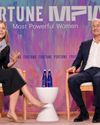Prøve GULL - Gratis
A WOUNDED INTEL BATTLES FOR SURVIVAL IN THE AI ERA
Fortune US
|October - November 2024
HENRY V had Agincourt. Gen. Robert E. Lee had Gettysburg. And Intel CEO Pat Gelsinger has Chandler. That would be Chandler, Ariz., outside Phoenix, where Intel is investing nearly $30 billion to build two state-of-the-art semiconductor plants, or fabs, that will be the first to use the company's newest chipmaking process. It's here, in Chandler, where Gelsinger's fate-and likely that of the company he leads will be decided.

Gelsinger, who was named CEO in 2021, has essentially bet the company on 18A, a new chipmaking process. He hopes it will position Intel as a viable alternative to Taiwan Semiconductor Manufacturing Co. (TSMC), the world's leading contract manufacturer of chips.
The reason for Intel's struggles is clear: It fell victim to a classic innovator's dilemma-not once but twice. First, early in the 21st century, its preoccupation with producing chips for PCs and data centers led it to miss the smartphone revolution. Then, in the past decade, it missed the emergence of chips designed for artificial intelligence.
Intel rival Nvidia took a type of chip originally designed for the demands of video games, the graphics processing unit (or GPU), and turned it into the workhorse for training and running AI models. Now the generative AI boom has made Nvidia one of the world's most valuable companies, worth more than $3 trillion, compared with Intel's relatively paltry $84 billion.
Gelsinger is racing to reverse Intel's slide by repositioning the company around manufacturing excellence, while also trying to establish Intel as a player in the market for AI chips. Many are skeptical he can pull it off and fear the company may be in permanent decline. Meanwhile, chipmaker Qualcomm has reportedly expressed interest in acquiring Intel in what would be among the biggest tech takeovers ever. At press time, it was unclear if a deal would happen or whether Intel would instead partner with another company for a cash infusion that doesn't involve a buyout.
Intel wound up in such dire straits owing to missteps in its core business for central processing units (CPUs), in which it was once the unrivaled king. Production delays and problems in its own fab facilities have let rival AMD steal significant market share.

Denne historien er fra October - November 2024-utgaven av Fortune US.
Abonner på Magzter GOLD for å få tilgang til tusenvis av kuraterte premiumhistorier og over 9000 magasiner og aviser.
Allerede abonnent? Logg på
FLERE HISTORIER FRA Fortune US

Fortune US
GET READY TO OWN A TOKENIZED PORTFOLIO
A BLOCKCHAIN \"FREIGHT TRAIN\" IS ALREADY REMAKING WALL STREET'S FINANCIAL PLUMBING. IT COULD MAKE TRADING EVEN FASTER AND CHEAPER
6 mins
December 2025 - January 2026
Fortune US
RESOURCES HOW RARE EARTHS BECAME GROUND ZERO IN THE U.S.-CHINA RIVALRY
THE WATERSHED moment came in July when the federal government became the largest shareholder of MP Materials, a California miner of rare earth elements.
2 mins
December 2025 - January 2026

Fortune US
PASSIONS A BLISSFUL ESCAPE FROM DECISION FATIGUE
THE TASTING MENU at Uberto ends, like many others at restaurants of this caliber, with mignardises.
4 mins
December 2025 - January 2026

Fortune US
JAMIE DIMON OF JPMORGAN CHASE ON STEERING AMERICA'S BIGGEST BANK THROUGH 'INFLATIONARY' TIMES
CEO JAMIE DIMON has led JPMorgan Chase through periods of rapid change and epic turmoil—and Jan. 1, 2026, will be his 20th anniversary in the role.
6 mins
December 2025 - January 2026

Fortune US
WHAT TO BUY, AND NOT BUY, IN 2026
THREE YEARS OF EUPHORIA IN STOCKS AND OTHER ASSETS HAVE INVESTORS BRACING FOR TROUBLE. HERE'S WHAT TO DO IF BAD NEWS ARRIVES.
7 mins
December 2025 - January 2026

Fortune US
Breaking the Mold
The Trade Desk's Al-powered platform and open-web ethos has propelled it onto the S&P 500.
2 mins
December 2025 - January 2026

Fortune US
WINE TARIFF THREATS AND GEN Z SOBRIETY HAVE PUT BORDEAUX ON RED ALERT
IN THE TASTING room of a Bordeaux winery, a photo on the wall shows a pastoral tableau: three generations of the Dubois family, sipping wine on the patio of their Les Bertrands château, with their Australian shepherd, Namek, perched at their feet.
6 mins
December 2025 - January 2026

Fortune US
HOW AN AI BUBBLE COULD RUIN THE PARTY
IF AI REVENUE DOESN'T CATCH UP WITH AI SPENDING, GLOBAL STOCKS WILL BE AT RISK.
6 mins
December 2025 - January 2026

Fortune US
INNOVATION IS THE ERA OF ROBOT-DRIVEN UNEMPLOYMENT ALMOST UPON US?
AT A PRESS EVENT LAST YEAR, Amazon Robotics chief technologist Tye Brady told Fortune that the idea that there's a battle of robots versus humans inside Amazon's warehouse network is a “myth.”
5 mins
December 2025 - January 2026

Fortune US
Nvidia is invincible. Unless it isn't.
The doubters are coming for the world's most valuable company.
11 mins
December 2025 - January 2026
Listen
Translate
Change font size
